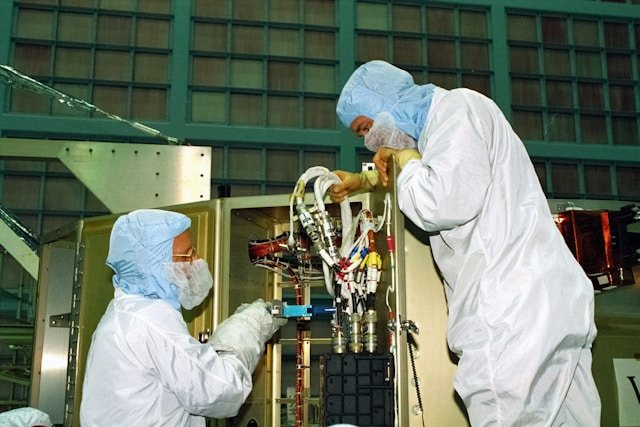Benefits of a Multipurpose Science and Technology Building
Why This Type of Building Is a Game-Changer
Most people think of a science and technology building as just a fancy lab stuffed with expensive gadgets. That’s it. A place where nerds wear lab coats and stare at machines. But that idea? It’s seriously outdated. Today’s multipurpose science and technology buildings are so much more than a lab or lecture hall. They’re designed to inspire, connect, and innovate. These aren’t just buildings – they’re buzzing ecosystems where creativity and science mix daily.
So, what is a multipurpose science and technology building exactly? Think of it as an all-in-one space that blends labs, classrooms, innovation hubs, and collaboration zones – all under one roof. It’s not stuck in the past. It’s flexible, modern, and built to grow with tech, not fall behind it.
Whether you call it a science and tech building, a multi-use research facility, or an academic science and technology hub, one thing’s clear: it’s reshaping how students, educators, and researchers work together. These buildings are now key players in pushing forward innovation on campuses worldwide.
And the best part? You don’t need to be a scientist to appreciate them. These buildings are for everyone — students, faculty, researchers, and even startups. They’re designed to bring minds together and create stuff that matters.
The Real Purpose Behind Multipurpose
Here’s the thing: not every space should stick to just one job. That’s where the genius of multipurpose science and technology buildings comes in. Instead of separate buildings for every department or program, these buildings bring it all together in one smart, functional space.
Picture this. One floor has tech-enabled classrooms where students brainstorm wild ideas. Another floor? A state-of-the-art lab where someone is testing those ideas. Maybe down the hall, there’s a collaborative workspace where students from engineering, biology, and design are working on the same project. That’s not a dream setup — it’s what’s happening inside modern multi-functional science buildings right now.
What makes them truly shine is their modular layout. Walls can move. Spaces can expand. Rooms can shift from a lecture hall in the morning to a hands-on lab by afternoon. It’s all about adaptability.
This kind of smart layout isn’t just trendy — it’s future-proof. Universities and colleges are turning to these modular academic buildings because they’re budget-friendly in the long run and more useful day to day.
And let’s not forget the vibe. When students from different departments share the same space, magic happens. Ideas cross paths. Collaboration sparks. That’s the true power of a multi-use research facility — it doesn’t just hold knowledge, it creates it.
So yeah, these buildings aren’t built just for science—they’re built for ideas to collide, grow, and launch into the real world.
Designed for Innovation: Layout That Fuels Creativity
Let’s get one thing straight — a multipurpose science and technology building isn’t just a boring box with classrooms and a few labs. That’s the biggest myth out there. People often think it’s all about function over form. But the truth? These buildings are designed with purpose, and creativity is at the core.
Step into a modern science and tech building, and it feels nothing like a traditional academic space. The design screams innovation. We’re talking about open spaces, glass walls, flexible rooms, and smart tech built into every corner. These aren’t just random aesthetic choices — they’re tools that help people think differently.
The layout plays a massive role in this. For instance, one space can shift from a private meeting room into a full-blown brainstorming zone. Why? Because flexible design matters. Especially in modern science and technology building layout ideas, where adaptability equals productivity.
You’ll also find technology-integrated learning spaces, where everything from interactive whiteboards to real-time data tracking is the norm. Classrooms aren’t just for lectures anymore. They’re places where ideas are tested, built, and improved right on the spot.
And let’s not forget those sleek STEM education buildings you see on top campuses. They’re a blend of labs, studios, lounges, and digital spaces — all working together to fuel cross-disciplinary innovation.
The bottom line? The design isn’t just nice to look at. It’s built to support how real innovation works — fast, collaborative, and ever-changing.
Collaboration at Its Core: Where Students, Teachers, and Tech Meet
There’s this old-school idea that students and teachers operate in silos — professors lecture, students listen, then everyone goes home. But that’s just not how learning or innovation works today. And that’s where the multipurpose science and technology building flips the script.
In these spaces, collaboration isn’t a feature — it’s the foundation. Students from engineering, biology, design, and even business work side by side. They’re building projects together. Solving real-world problems. Sharing ideas across departments in a way that just doesn’t happen in traditional setups.
Imagine walking into a collaborative STEM environment — you might see students prototyping a robot while others nearby are coding an app to run it. Or maybe a student-driven tech space where a startup is being built from scratch with support from professors, mentors, and peers. That’s the kind of synergy these buildings are made for.
These aren’t isolated classrooms or closed-off labs. They’re co-working spaces in education designed for active engagement. There’s always movement. Always energy. And always a mix of skills and perspectives blending in one place.
Plus, faculty aren’t sitting in hidden offices. They’re in the mix — mentoring, guiding, bouncing ideas. That shift in dynamic is powerful. It creates an environment where learning feels like working on something real and meaningful.
So when we talk about how multipurpose science buildings support innovation, we’re not just throwing buzzwords around. These buildings break down barriers. They help people collaborate like never before — and that’s where the magic happens.
Boosting STEM Learning Like Never Before
Let’s bust a myth: just having high-tech labs and fancy equipment doesn’t automatically make learning better. A building alone isn’t enough. But when that building is a multipurpose science and technology building? That’s a whole different story.
These buildings are designed to actually support how students learn best — through doing. You’re not stuck in a seat memorizing slides. You’re moving, building, testing, and solving problems. And that’s why they’ve become a game-changer for STEM education.
Inside a STEM-focused multipurpose building, you’ll find way more than your average classroom. You’ll see tech-enabled learning spaces where lectures turn into live experiments. You’ll find innovation labs where students can try out ideas in real time. And you’ll see how hands-on learning centers let students work with real tools, real data, and real problems — not just theories.
The goal? Help students connect the dots between science, technology, engineering, and math — in one space that makes all that knowledge come alive. These buildings push past old-school teaching and offer something way more exciting: technology-integrated learning that mirrors how things work in the real world.
And it’s not just about flashy tech. It’s about creating an environment where curiosity thrives. Where students feel like problem-solvers, not just passive learners. And when that happens? That’s when real innovation starts.
Sustainability Matters: Green Science and Tech Buildings
Here’s what most folks get wrong: they think buildings like these, with all their tech and equipment, must be energy hogs. But the truth is, many multipurpose science and technology buildings are built with sustainability at the heart of their design.
These aren’t the concrete jungles of the past. They’re smart, green, and forward-thinking. From solar panels to energy-saving lighting to rainwater systems, modern green technology buildings are changing the game.
One of the coolest features in many of these spaces is their use of sustainable materials. We’re talking low-impact flooring, recycled finishes, and smart construction choices that reduce the carbon footprint right from the start.
Plus, most of these buildings use smart energy systems that monitor usage in real-time. That means lights go off automatically, temperatures stay balanced, and resources aren’t wasted. It’s all part of creating future-proof science buildings that don’t just support learning — they protect the planet too.
Some schools even turn these buildings into live case studies. Students actually analyze how much energy the building saves or how efficient its systems are. So now, the building itself becomes part of the learning experience — how cool is that?
So yes, you can have a high-tech space that’s also eco-friendly. These buildings prove that innovation and sustainability can go hand in hand. And with more focus on sustainable features in science and tech buildings, it’s clear this is the direction smart campuses are heading.
Affordable Innovation: Why Multipurpose Buildings Save Money in the Long Run
A common belief is that multipurpose science and technology buildings are an unnecessary luxury — that they’re too expensive to build and maintain. But here’s the truth: these spaces save a lot of money in the long run.
Let’s break it down. Typically, universities or research facilities would need multiple buildings, each dedicated to a specific function, whether it’s classrooms, labs, or common areas. That means more construction costs, more utility bills, more maintenance staff, and just a lot more overhead.
With multipurpose science buildings, it’s all under one roof. Instead of having separate buildings for each department or function, you get everything from collaborative workspaces to research labs and even lecture halls in a single space. This cuts down on costs right from the start. Fewer buildings mean fewer expenses on maintenance, cleaning, and utilities.
Plus, these buildings are often designed to be highly energy-efficient, using smart systems that adjust to occupancy levels, weather, and more. That leads to significant savings on things like heating and cooling.
The result? You get a high-tech, flexible space that keeps costs low while providing a world-class learning environment. When you invest in a multi-use building, you’re not just spending money — you’re saving it.
Looking to the Future: How These Buildings Are Shaping Tomorrow’s Innovations
There’s one thing that almost everyone gets wrong when they think about multipurpose science and technology buildings: they think of them as static, unchanging structures. Something built and then left to run its course.
But here’s the deal: these buildings aren’t just buildings. They’re living labs, constantly evolving to meet the needs of a fast-paced world.
These spaces are designed to adapt and grow as technology advances. For example, as new technologies in science and engineering emerge, the layout or the systems of the building can be easily upgraded. Maybe that means adding a new robotics lab or installing cutting-edge AI-powered learning tools. With a flexible design, you’re not tied down to outdated systems — you’re ready for the future.
And it’s not just about tech. It’s about people. These buildings are being built with future generations in mind. They promote collaboration, encourage cross-disciplinary work, and create an environment where innovation isn’t just possible — it’s inevitable. The ability to adapt to future demands is the key to staying relevant, both for educational institutions and the industries they support.
When we talk about how multipurpose science and technology buildings shape tomorrow’s innovations, it’s more than just the tech inside. It’s about creating spaces that encourage the kind of thinking and creativity that lead to breakthroughs. It’s about fostering an atmosphere that nurtures the next wave of innovators, leaders, and problem-solvers.
In short, these buildings aren’t just structures — they’re an investment in the future.
The Role of Technology in Multipurpose Science and Technology Buildings
If you think multipurpose science and technology buildings are just regular spaces with a few computers and whiteboards, think again. These buildings are packed with technology that enhances every aspect of learning, collaboration, and innovation.
One of the most important features? Smart technology. Think automated lighting, HVAC systems that adjust based on occupancy, and digital tools that help students and faculty stay connected. These systems aren’t just cool gadgets — they save energy, improve productivity, and ensure the building is running efficiently.
Additionally, many of these buildings are equipped with state-of-the-art technology labs, such as robotics workspaces, AI-driven research labs, and data analytics centers. Students have access to tools that allow them to work with cutting-edge technology, often in real-time. This is hands-on learning at its finest.
And let’s not forget about virtual reality (VR) and augmented reality (AR). These immersive technologies are starting to become a regular part of the learning process. Imagine being able to walk through a 3D molecular structure in a chemistry class or using AR to explore engineering designs. It’s the future of learning, and these multipurpose buildings are at the forefront.
So, when we talk about technology-driven learning, it’s not just about the fancy tech inside the building. It’s about creating an ecosystem where technology empowers every student and researcher to achieve their potential.
Conclusion: Multipurpose Science and Technology Buildings Are the Future
In the end, multipurpose science and technology buildings aren’t just a trend — they’re shaping the future of education, innovation, and collaboration. From flexible layouts that adapt to changing needs to eco-friendly features that save money and resources, these buildings represent the next step in building smarter, more sustainable campuses.
By promoting collaboration, hands-on learning, and sustainable design, they’re creating an environment where creativity can thrive. These spaces aren’t just for learning. They’re for doing. For creating. For solving the world’s biggest problems.
The role of technology in science buildings cannot be overstated either. From smart energy systems to virtual reality classrooms, the future of these spaces is all about interactivity, adaptability, and future-proofing.
If you’re thinking about the future of educational spaces, innovation hubs, or research facilities, look no further than these multipurpose buildings. They’re not just classrooms or labs — they’re dynamic spaces designed for the next generation of thinkers, creators, and innovators.
Final Words
Multipurpose science and technology buildings are much more than just physical structures. They’re dynamic environments that foster creativity, collaboration, and innovation. With cutting-edge technology, eco-friendly designs, and flexible layouts, these buildings are setting the stage for the future of education and research. They prove that innovation isn’t just about what’s inside the classroom — it’s about creating spaces that inspire progress and change.
As these buildings continue to evolve, so too will the possibilities for STEM education, sustainability, and the role of technology in shaping tomorrow’s leaders. So, whether you’re an educator, student, or someone just passionate about the future of innovation, multipurpose science and technology buildings are the place to watch.






